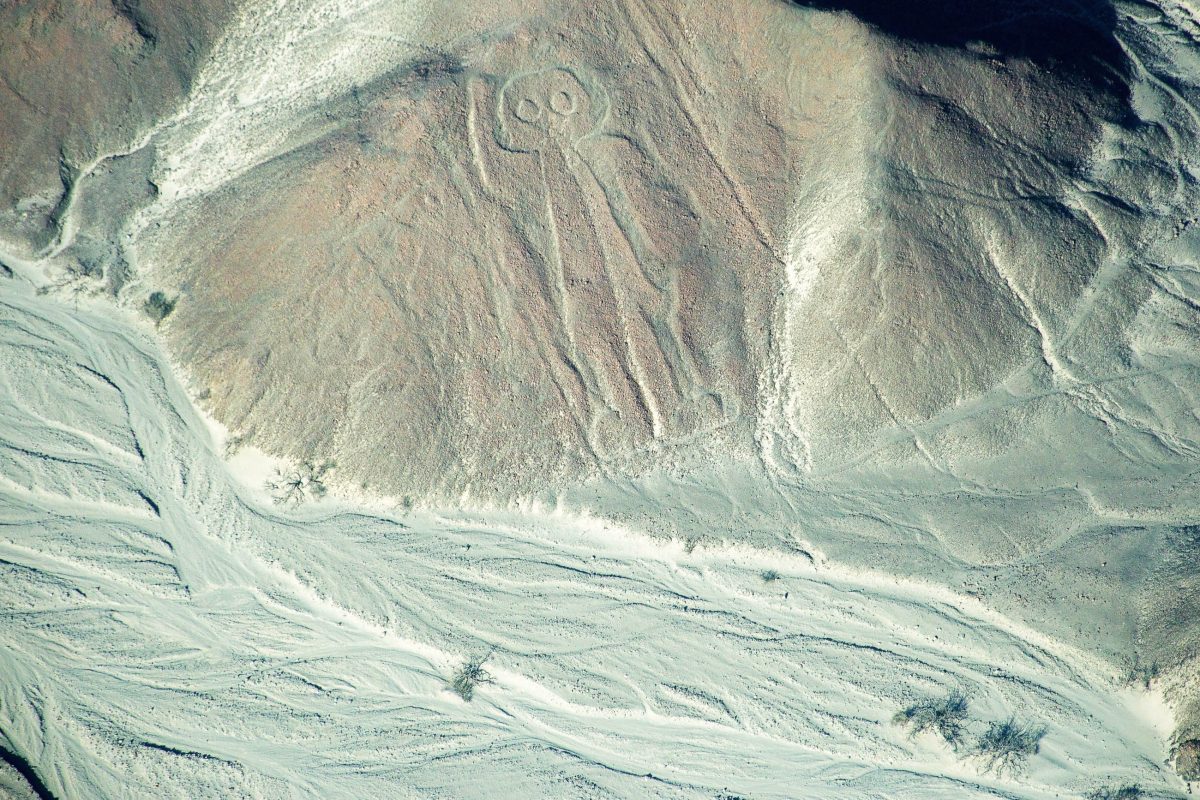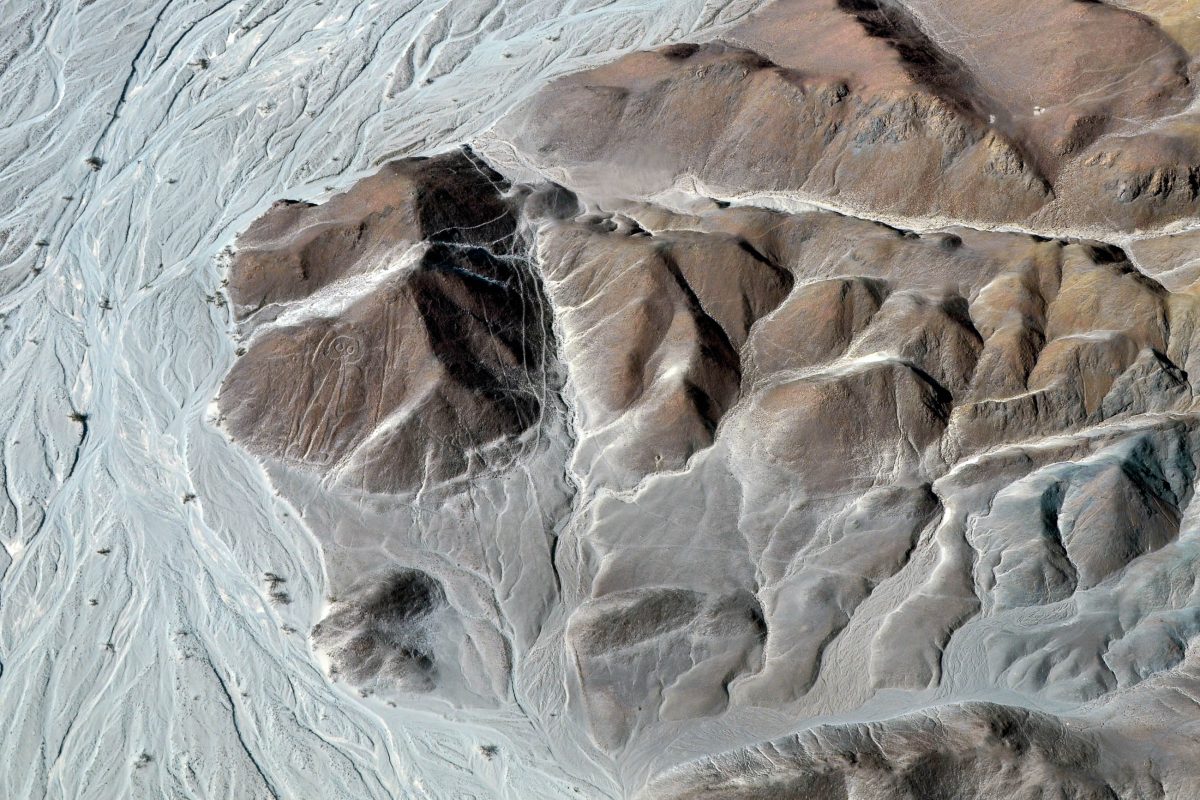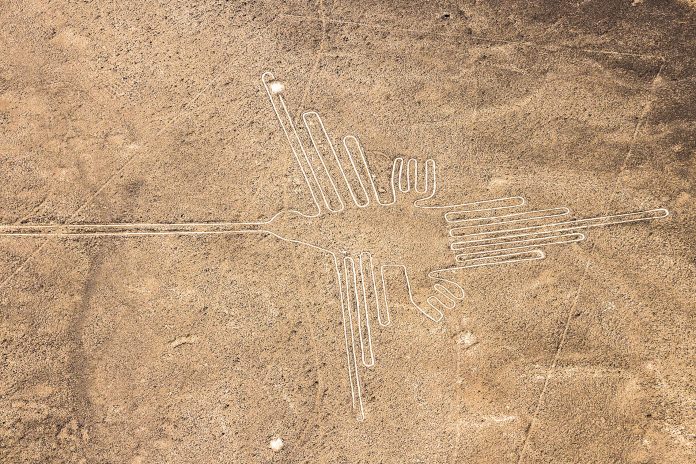In der Nazca-Ebene und den Pampas de Jumana wurden von etwa 1.000 vor bis 500 nach Christus fantastische Bodenzeichnungen gefertigt. Die über 1.500 geometrischen Linien in der Erdkruste formen sich zu hunderte Meter großen Figuren und kilometerlangen Mustern, deren Bedeutung bis heute unklar ist.
Die Bodenzeichnungen bei Nazca und in den Pampas de Jumana in der Küstenwüste Perus liegen etwa 400 Kilometer südlich der Landeshauptstadt Lima. Sie sind eines der rätselhaftesten Phänomene Südamerikas und zählen zu unseren Top 10 Sehenswürdigkeiten von Peru.
Auf einer Fläche von rund 450 Quadratkilometern erstrecken sich bis zu 20 Kilometer lange geometrische Muster und Linien, sowie bis zu 100 Meter messende Scharrbilder. Aufgrund ihrer Größe sind sie teilweise nur aus der Luft zu sehen. Über 70 verschiedene Figuren wurden identifiziert, darunter Vögel, Menschen, Insekten, Affen und sogar Wale, einige davon in erstaunlicher Symmetrie gezeichnet.
Inhaltsverzeichnis
BILDER: Nazca – Bodenzeichnungen
Fotogalerie: Bodenzeichnungen bei Nazca
Entstehung und Entdeckung der Nazca-Linien
Die ersten Linien wurden in der Chavín-Periode, etwa 1.000 bis 300 vor Christus, durch angeordnete Steine gezeichnet. Erst danach, in der Nazca-Periode, etwa 500 vor bis 500 nach Christus, entstanden die heute sichtbaren Scharrbilder, indem die Nazca den dunklen Kies an der Erdoberfläche oft nur wenige Zentimeter tief beiseite kratzten und so die untere hellere Schicht freilegten.
Einer Theorie zufolge sollten diese eine ähnliche Funktion erfüllen, wie die Pyramiden von Ägypten – je größer die Bilder, desto mächtiger der amtierende Herrscher, der sie in Auftrag gab.
Entdeckt wurden die faszinierenden Geoglyphen erst 1924, als die ersten Fluglinien über die Nazca-Ebene führten und ein Pilot die eindeutig nicht natürlichen Linien ausmachen konnte. Ihre Bedeutung ist, wie ihre Schöpfer, bis heute unbekannt.
Die mysteriöse Entdeckung führte zu den verschiedensten Theorien über ihren Zweck. Von spirituellen Straßen über rituelle Pfade bei Opferzeremonien bis hin zu einem gewaltigen Kalender war die Rede. Ebenso wurde die Beschwörung von Regen oder eine gigantische Sportarena als Erklärung in Betracht gezogen.
Nazca-Figuren: Ein Gruß von Aliens?

Bei derartig mysteriösen Entdeckungen darf natürlich auch die Theorie über die Entstehung durch außerirdische Künstler nicht fehlen. Der Schweizer Schriftsteller Erich von Däniken verbreitete die wohl berühmteste parawissenschaftliche Erklärung des Cargo-Kultes. Er argumentierte, dass Menschen damals diese Linien unmöglich erschaffen konnten, da sie vom Boden aus nicht einmal zu sehen waren.
Einige der Strukturen hätten außerdem erstaunliche Ähnlichkeit mit Landebahnen und Rollfeldern für Raumschiffe. Die dargestellte Figur des „Astronauten“ ist eigentlich eine Abbildung eines Aliens, auf deren Besuch auch die damals idealtypischen länglichen Schädelformen hinweisen würden. Trotz der eher haarsträubenden Geschichte und vor allem aufgrund des Mangels an wissenschaftlich fundierten Alternativmöglichkeiten hat sich die Theorie des Cargo-Kultes bis heute gehalten.
Nazca-Figuren: Bis heute ein Rätsel!

Von Wissenschaftlern wird angenommen, dass die Nazca-Linien eine agrikulturelle, astronomische und religiöse Bedeutung haben. Viele der beeindruckend symmetrischen Figuren weisen deutliche Zusammenhänge mit Sonnenwendpunkten auf. Mittlerweile wurden über 1.500 Linien mit GPS vermessen und systematisch erforscht, weitere Scharrbilder sind im Zuge der Untersuchungen aufgetaucht.
Aufgrund der vielen Besucher und Forscher sind einige der Linien durch Fuß- und Autospuren zerstört worden. Die deutsche Forscherin Maria Reiche widmete ihr ganzes Leben dem Studium der geheimnisumwitternden Nazca-Linien und setzte sich auch für deren Schutz ein. Ihr ist es auch zu verdanken, dass die Bodenzeichnungen 1994, vier Jahre vor ihrem Tod, zum Weltkulturerbe der UNESCO erklärt wurden.
Die schönsten und größten Nazca-Bilder

Die größte der Nazca-Linien stellt einen abstrahierten Vogel mit gewundenem Hals dar. Der „Pelikan“ weist eine Länge von knapp 300 Meter auf. Durch ihre perfekte Symmetrie beeindrucken der „Kolibri“, die „Spinne“ und der äußerst detailgetreue Kondor, der 70m große „Affe“ glänzt mit seinem übergroß dargestellten eingeringeltem Schwanz.
Zu sehen sind die spektakulären Bodenzeichnungen am besten vom Flugzeug aus. 30-45minütige Flüge werden von Reiseagenturen in Nazca oder in kleinen Maschinen direkt am Flughafen vor Ort angeboten. Es gibt an der Panamericana bei Kilometer 425 auch einen Aussichtsturm über die Nazca-Ebene. Von dem aus ist aber außer den „Händen“ nicht viel von den Scharrbildern zu sehen.
Weiterführende Links:
Genaue Abbildungen der Scharrbilder inkl. Beschreibung auf flickr.com





